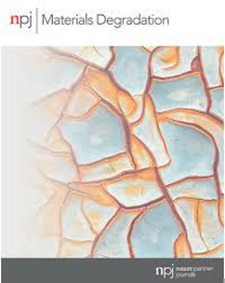水泥基灌浆料的矿物学和地球化学组成及其与水作用过程中的演变
IF 7.6
2区 材料科学
Q1 MATERIALS SCIENCE, MULTIDISCIPLINARY
引用次数: 0
摘要
本研究采用化学和物理相结合的方法,研究了基于 CEM III/C 的水泥基灌浆料的化学成分、矿物学和变化机理,并添加了埃克石、水滑石和硅灰。这种材料是在放射性废物地质处置库的背景下设计的,有两个目的:第一,填补地质构造和处置廊道之间的界面上钻孔作业留下的技术空隙。其次,中和黄铁矿氧化可能产生的瞬时酸性,并创造有利于降低碳钢腐蚀率的环境。灌浆料主要由硅酸钙水合物组成,Ca/Si 比约为 0.8,在硅链(C-A-S-H)的桥接部位含有 Al,占样品的 29-36%。它还含有硅灰(38-48 重量%)、含层间 Na 的闪长岩(11-17 重量%)、含层间 CO32- 的水滑石(3-4 重量%),以及较少量的波长岩、方解石,可能还有辉绿岩和石膏。水在流动反应器中改变样品时,影响样品的主要变化是方解石和石膏的溶解,从而释放出水溶液中的 Ca2+,Ca2+通过取代 Na+吸附在辉绿岩夹层中,以及化学计量的 C-A-S-H 溶解。利用热动力学模型成功地再现了溶液化学和固相组成的演变过程。本文章由计算机程序翻译,如有差异,请以英文原文为准。

Mineralogical and geochemical composition of a cementitious grout and its evolution during interaction with water
In the present study, the chemical composition, mineralogy, and mechanisms of alteration of a cementitious grout based on a CEM III/C with addition of smectite, hydrotalcite, and silica fume, are studied using a combination of chemical and physical methods. This material was designed in the context of geological repository of radioactive wastes, with a twofold aim: first, to fill the technical voids left by drilling operations at the interface between the geological formation and the disposal galleries. Second, to neutralize a potential acidic transient due to pyrite oxidation, and to create an environment that favors low corrosion rates of carbon steels. The grout is mainly composed of calcium silicate hydrates having a Ca/Si ratio of ~0.8, incorporating Al in the bridging site of the Si chains (C-A-S-H), and accounting for 29–36 wt.% of the sample. It also contains silica fume (38–48 wt.%), smectite with interlayer Na (11–17 wt.%), hydrotalcite with interlayer CO32− (3–4 wt.%), and lower amounts of portlandite, calcite, and possibly gibbsite and gypsum. Upon alteration by water in a flow-through reactor, the main modifications affecting the sample are calcite and gypsum dissolution, hence releasing aqueous Ca2+ that is adsorbed in smectite interlayer by replacing Na+, and stoichiometric C-A-S-H dissolution. The evolution of solution chemistry and of the solid phase composition are reproduced successfully using a thermokinetic model.
求助全文
通过发布文献求助,成功后即可免费获取论文全文。
去求助
来源期刊

npj Materials Degradation
MATERIALS SCIENCE, MULTIDISCIPLINARY-
CiteScore
7.80
自引率
7.80%
发文量
86
审稿时长
6 weeks
期刊介绍:
npj Materials Degradation considers basic and applied research that explores all aspects of the degradation of metallic and non-metallic materials. The journal broadly defines ‘materials degradation’ as a reduction in the ability of a material to perform its task in-service as a result of environmental exposure.
The journal covers a broad range of topics including but not limited to:
-Degradation of metals, glasses, minerals, polymers, ceramics, cements and composites in natural and engineered environments, as a result of various stimuli
-Computational and experimental studies of degradation mechanisms and kinetics
-Characterization of degradation by traditional and emerging techniques
-New approaches and technologies for enhancing resistance to degradation
-Inspection and monitoring techniques for materials in-service, such as sensing technologies
 求助内容:
求助内容: 应助结果提醒方式:
应助结果提醒方式:


